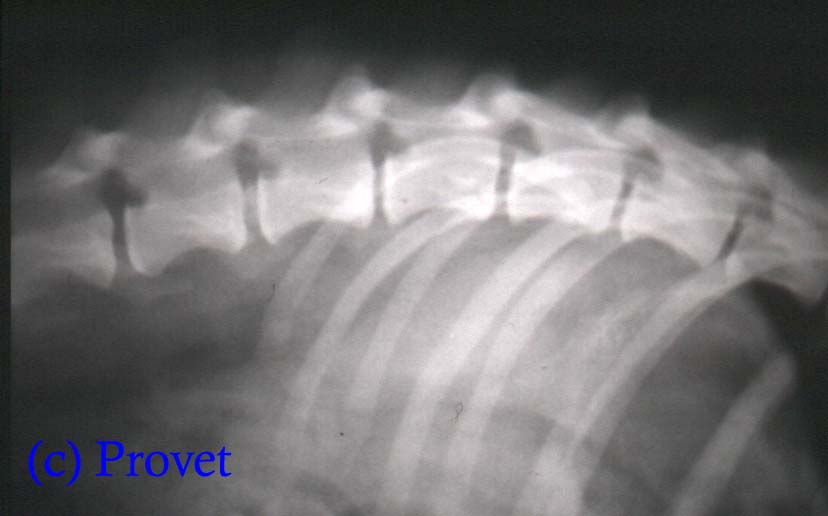 Back
Back
PARALYSIS First broadcast on www.provet.co.uk |
This information is provided by Provet for educational purposes only.
You should seek the advice of your veterinarian if your pet is ill as only he or she can correctly advise on the diagnosis and recommend the treatment that is most appropriate for your pet.
Animals are often described as being "paralysed" - but what does it mean ?
The term paralysis means :
- loss of voluntary muscle function OR
- loss of sensation
in a part or area of the body.
The underlying cause is usually disease or injury to part of the nervous system or muscular system :
- Central nervous system - the brain or spinal cord
- Peripheral nervous system - the nerves, and where the nerves join to muscles at so-called neuromuscular junctions
- The muscles themselves may fail to respond to neurological stimulation
Paralysis can be very localised - for example just affecting the area of the body supplied by a single nerve branch , or by a single muscle, or it can be more generalised. Paralysis can affect one limb or more than one limb, one side of the body or both sides of the body. Paralysis can also affect internal organs - for example the urinary bladder may cease to function and so the animal is unable to eliminate urine - a very serious disorder which can be life-threatening.
Other terms may be used to describe the type of paralysis, for example :
- Hemiplegia - paralysis of one side of the body
- Paraplegia - paralysis of the lower part of the body (in humans) the rear end of the body (behind the chest) in animals. This is usually as a result of a spinal injury or spinal disease, and is often the result of disk protrusion.
- Quadriplegia or tetraplegia - paralysis of all four limbs. This may occur if there is a neck injury such as a fractured spine, or as a result of a brain injury.
- Paresis - means partial or slight paralysis
Sometimes temporary paralysis can be induced by blocking neuromuscular function, for example :
- Local anaesthetics literally block the function of nerves near to where they are applied, and cause paralysis of the areas of the body that the nerves supply. Sometimes the area paralysed can be a long way from the site of the injection, for example blocking spinal nerves high on the back where they leave the spinal cord can paralyse a large area of the abdominal wall - sufficient that a caesarean section can be performed in a cow ! Applying a local anaesthetic into the spinal canal (called an epidural) can create a temporary paraplegia - again sufficient for a caesarean section to be performed.
- Cold can induce paralysis, and applying freezing cold temperatures to tissues can eliminate pain sensation from an area sufficiently that surgery can be performed (called cryosurgery)
- Pressure - such as lying heavily on a limb and pressing on a nerve
- If the blood supply is cut off from muscles for a period (eg following use of a tourniquet, or following an embolism).
- If the blood supply is cut off to the brain (eg a stroke) it may result in temporary or permanent paralysis. Strokes are rare in animals, but in humans the paralysis may be permanent if the blood supply to the brain is cut off for too long leading to irreversible brain damage
In clinical cases paralysis can be permanent in some cases, in other cases the paralysis is partially or totally reversible. Successful treatment depends upon the underlying cause, accurate diagnosis and adequate time for healing to take place. In some cases urgent treatment can significantly influence the outcome - for example removing pressure on the spinal cord following a "slipped disk" can greatly improve the outcome if surgery to decompress the area is performed soon after the disk ruptures.

An Xray of a dog with a calcified "disk" between two spinal vertebrae
Large animals that become paralysed present problems for owners because they may lose control of their bowels or urinary bladder, and even if they don't, they are unable to move about normally and may become soiled with faeces and urine. Paralysis in some areas of the body present the animal with all sorts of complications. For example paralysis of the larynx (common in old dogs, especially male Labrador retrievers) results in difficulty breathing and exercising, and also affects swallowing so that food may enter the windpipe and get into the lungs resulting in pneumonia.
Veterinarians and owners often find it difficult to decide how long to leave an animal before the paralysis is regarded as being permanent and irreversible, and whether or not euthanasia should be performed. Such a drastic decision really depends on the quality of life that the animal has, and the social situation and commitment of the owners and family. Even if an animal is permanently paraplegic - providing there is no pain and the animal is not faecally or urinary incontinent it is a very difficult decision to make. Many owners nowadays keep their paralysed pets going, using modern aids such as specially designed carts to improve mobility ...we have covered this before on Provet CLICK HERE for further information.
Updated October 2013